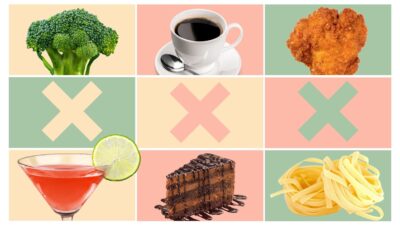- General Definition
Carbohydrates, proteins, and fats are sources of energy.
Vitamins, however, are not energy sources but are essential for vital energy and chemical reactions in the body.
Vitamins are essential elements to maintain health.
They are classified based on their solubility into two groups:
- Fat-soluble vitamins: A, D, E, K.
- Water-soluble vitamins: C and the B complex vitamins.
Vitamin A (Retinol)
- Properties of Vitamin A
- It is not water-soluble but dissolves in fat solvents such as ether, benzene, and chloroform.
- Resistant to heat and alkaline conditions.
- Found in:
- Retinol form in animal sources (such as liver).
- Carotenoid form in plant sources (such as carrots and spinach).
- Its absorption requires:
- Bile salts,
- Lipase enzyme,
- Dietary fats.
- Functions of Vitamin A
- Supports the immune system against diseases.
- Contributes to bone growth and the reproductive system.
- Improves vision in low-light conditions (eyes).
- Acts as an antioxidant protecting the body against cancer and aging (via carotenoids).
- Maintains healthy skin tissues and mucous membranes (mouth, stomach, intestines, respiratory and urinary systems) and prevents infections.
- Vitamin A Deficiency and Toxicity
- It is stored in the body, so deficiency symptoms appear after a long period of inadequate intake.
- Deficiency symptoms include:
- Night blindness (the first and most important symptom).
- Dry eyes (xerophthalmia), Bitot’s spots, vision loss.
- Skin keratosis (hyperkeratosis of hair follicles).
- Poor digestion and absorption, increased vulnerability to infections.
- Delayed growth.
- Toxicity:
- Occurs when intake exceeds daily needs by 10 times or more, causing toxic symptoms.
- Sources of Vitamin A
- Animal sources (retinol):
- Liver,
- Cod liver oil,
- Milk and dairy products,
- Butter,
- Eggs.
- Plant sources (carotenoids):
- Dark green leafy vegetables (such as spinach),
- Yellow and orange vegetables (such as carrots and pumpkin),
- Orange fruits (such as peaches and apricots).
- Recommended Daily Intake of Vitamin A
| Age Group | Daily Requirement (mcg Retinol Equivalent) |
|---|---|
| 2-3 years | 250 |
| 4 years | 250 |
| 5-6 years (boys/girls) | 300 |
| 7-10 years (boys/girls) | 400 |
| 11-14 years | 600 |
| ≥15 years (males) | 750 |
| ≥15 years (females) | 650 |
| Pregnancy | 700 |
| Lactation | 1300 |
(Source: Turkish Nutrition Guide – Türkiye Beslenme Rehberi)
Quick Summary
Vitamin A is essential for vision, immunity, and skin health.
Its sources are varied, including animal and plant-based foods.
Deficiency causes serious visual and skin problems.
Excess intake can cause severe toxicity.




